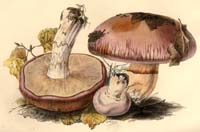 Key to Gilled Mushrooms Key
Key to Gilled Mushrooms KeyThis is a key to gilled mushrooms, that is, mushrooms having a definite cap with a fertile surface consisting of gills. The fruiting body usually also has a stem, although that may be lateral or absent (usually, then, the mushroom is growing from wood). You can use this key to identify mushrooms that you find.
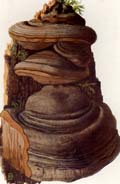 Polyporaceae Family
Polyporaceae FamilyFertile surface usually a layer of vertical tubes, of which the mouths are visible as pores on the underside of the cap or shelf.
Fruiting bodies usually tougher or harder than the "normal" gilled mushrooms, being leathery, corky, or woody. But they can be quite tender while actively growing
Once grown, they do not decay easily, remaining on the substrate for months or years
They often grow on wood, although a few are terrestrial (even those are usually growing on buried wood)
Fruiting body is usually a flat shelf, or hoof-shaped, protruding directly from the substrate, although sometimes it may have a short stalk.
Some forms never grow away from the substrate at all, so that all that is visible of the fruiting body are the pores.
Sometimes the pores are so minute that the fertile surface seems solid, until you look closely
 Lignicopolypore Subfamily
Lignicopolypore SubfamilyGrowing on wood
Sessiloporus TribeNot fitting the other choices, not stipitate
In making choices below based on texture and size, place the emphasis on texture: if left alone, some of the smaller ones can eventually get quite big; and even the huge ones have to start out small at first
 Big Sessilopolypore Subtribe
Big Sessilopolypore SubtribeFruiting body large (often over 6" across), perennial and hard; often hoof-shaped or convex, but may also be shelving
If the choice is between this and Medium Sessilopolypore, place fungi here if they have any of the following characters: perennial, hoof-shaped, hard
Phellinus Genus Quélet
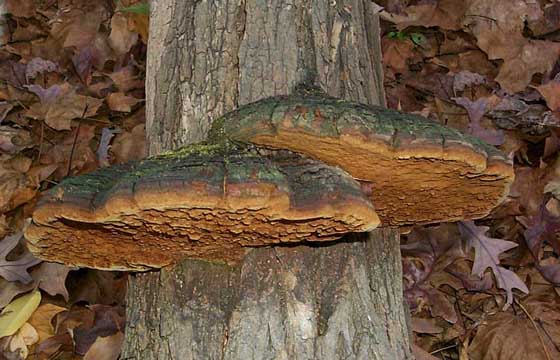
Diagnosis
- Context dark reddish brown or yellowish brown, staining black with KOH
-
Causing a white rot in living wood
Narrow down your identification:
Phellinus everhartiiFruiting bodies up to 16" wide
Cap yellow-brown where growing (often only at the margin), rusty brown elsewhere; hard, crusty, with deep cracks
On oak
Spore print brown
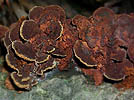 Phellinus gilvus
Phellinus gilvusCap yellow-brown where growing (often only at the margin), rusty brown elsewhere; velvety at first, becoming bald
Pores greyish brown becoming reddish brown and eventually dark brown (like cap), 4-8 per mm
Flesh yellow-brown, tough-corky when fresh
Fruiting bodies 1-6" wide, often compound or in imbricate clusters, 1 mm to almost an inch thick, often somewhat zoned or roughened
On hardwoods
Spore print whitish
 Phellinus ignarius
Phellinus ignariusCap brown and velutinate where growing (often only at the margin), bald and grey to black otherwise; often furrowed or cracked
Pores greyish brown to brown, 4-5 per mm
Each pore layer 2-5 mm long, but they may be stacked (over many years) up to four inches deep
On dead deciduous wood
Spore print white
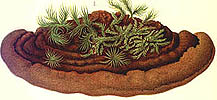 Phellinus pini
Phellinus piniFruiting bodies 1-8" across, 1/2 - 6" thick
Cap hard, crusty, not furry; roughened in zones
On living or recently dead conifers. Tawny to reddish brown at first, darkening almost to black in age
Pores tan to rusty brown, becoming brown, 2-5 per mm
Spore print brown
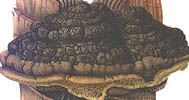 Phellinus rimosus
Phellinus rimosusUsually on locust
Cap with deep cracks, brown becoming blackish, margin concolorous with rest of cap
Pores minute (4-6 per mm), yellow-brown to deep brown
Spore print brownish
Phellinus torulosusCap up to 6" across
Stalk with a bulbous base

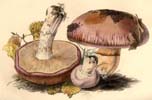


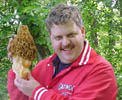

 Key to Gilled Mushrooms Key
Key to Gilled Mushrooms Key Polyporaceae Family
Polyporaceae Family Phellinus pini
Phellinus pini Phellinus rimosus
Phellinus rimosus




